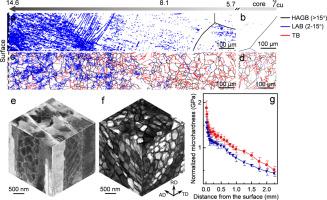Microstructure evolution in multi-principal element alloy with millimeter-sized grains subjected to cyclic torsion
IF 8.3
1区 材料科学
Q1 MATERIALS SCIENCE, MULTIDISCIPLINARY
引用次数: 0
Abstract
In the previous report [Acta Materialia 275 (2024) 120,059], the dislocation patterns and evolution process of fine-grained Al0.1CoCrFeNi multi-principal element alloy with an average grain size of 46 μm were investigated at varying cumulative plastic strains, γcu, by double-beam TEM observations. To further understand larger grain size effect, the mechanism of intrinsic dislocation activities in the same alloy with millimeter-sized grains at the same loading conditions was studied in this paper. Different from the extensive proliferation of multi-slip dislocation activities and the resultant randomly distributed Lomer-Cottrell (L-C) locks and cells in the fine-grained alloy, multiple dislocation slip containing less slip-systems and parallel ordered L-C locks are preferentially activated, consequently promoting the generation of profuse geometrically necessary boundaries (GNBs) in the interior of millimeter-sized grains. With further increasing γcu, the GNBs progressively increases in the density and decrease in spacing, which also accelerates the formation of ultrafine-scale dislocation cell pattern.


求助全文
约1分钟内获得全文
求助全文
来源期刊

Acta Materialia
工程技术-材料科学:综合
CiteScore
16.10
自引率
8.50%
发文量
801
审稿时长
53 days
期刊介绍:
Acta Materialia serves as a platform for publishing full-length, original papers and commissioned overviews that contribute to a profound understanding of the correlation between the processing, structure, and properties of inorganic materials. The journal seeks papers with high impact potential or those that significantly propel the field forward. The scope includes the atomic and molecular arrangements, chemical and electronic structures, and microstructure of materials, focusing on their mechanical or functional behavior across all length scales, including nanostructures.
 求助内容:
求助内容: 应助结果提醒方式:
应助结果提醒方式:


